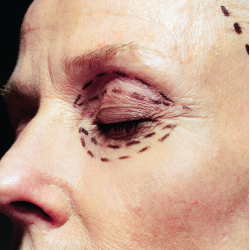 TRIO Best Practice articles are brief, structured reviews designed to provide the busy clinician with a handy outline and reference for day-to-day clinical decision making. The ENTtoday summaries below include the Background and Best Practice sections of the original article. To view the complete Laryngoscope articles free of charge, visit Laryngoscope.
TRIO Best Practice articles are brief, structured reviews designed to provide the busy clinician with a handy outline and reference for day-to-day clinical decision making. The ENTtoday summaries below include the Background and Best Practice sections of the original article. To view the complete Laryngoscope articles free of charge, visit Laryngoscope.
Explore This Issue
July 2019Background

Blepharoplasty.
© Conely Jay / Science Source
Blepharoplasty is a common procedure performed for cosmetic and functional purposes. As with all surgical procedures, careful preoperative assessment is important to minimize the risk of postoperative complications. Known complications include dry eye syndrome, epiphora, diplopia, strabismus, ptosis, lid malposition, and changes in visual acuity. Dry eye syndrome consists of insufficient tear formation or decreased ability to maintain ocular lubrication, which can result in disorders of the surface of the eye. In addition to potential damage to the lacrimal gland, blepharoplasty can change the way a person blinks and can impact eye closure. Surgeons might avoid operating on patients who suffer from dry eye due to concern that blepharoplasty could exacerbate symptoms. Some have proposed that these risks necessitate formal tear production testing or specific ophthalmologic evaluation preoperatively.
The Schirmer’s test is one of the most commonly performed tear production tests and is often regarded as the gold standard. In the Schirmer’s I test, the basal and reflex tear formation is measured using filter paper placed inside the lower eyelid, whereas the Schirmer’s II test measures basal tear formation on the filter paper after an anesthetic is applied to the eye. An abnormal Schirmer’s test occurs when the wetting of the filter paper is less than 10 mm after five minutes, whereas normal wetting ranges from 15mm to 30 mm. Performing the Schirmer’s test could potentially be beneficial in identifying patients who may be at risk for developing dry eye postoperatively as well as those who could benefit from more conservative surgical approaches. However, is a Schirmer’s test necessary prior to a blepharoplasty?
Best Practice
The Schirmer’s test results can aid in identifying patients with subclinical dry eye; however, given the lack of reliability of the test, it is not essential in the preoperative evaluation of blepharoplasty patients. The use of preoperative tear production testing can be limited to those with MPE (proptosis, exophthalmos, lagophthalmos, hypotonia of the lower eyelid, and inferior scleral show) or those at high risk for dry eye syndrome postoperatively based on physical examination or preoperative complaint of dry eyes (Laryngoscope. 2019;129:1021–1022).